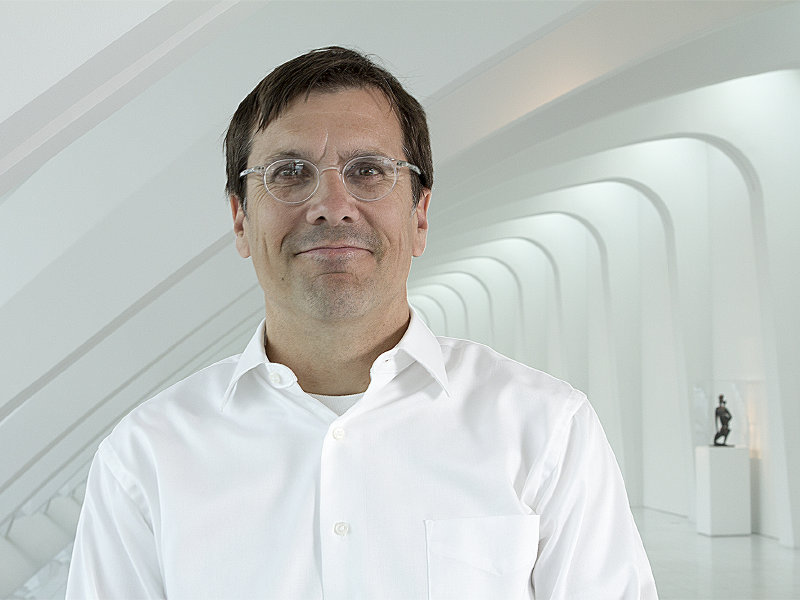If you're a devotee of the Milwaukee Art Museum's wonderful Bradley Collection, you might find the revamped galleries housing Peg -- aka Mrs. Harry Lynde -- Bradley's generous 1975 gift a little disconcerting at first.
Utrillo's Parisian urban landscape isn't where it's supposed to be and where are the wind-blown schoolchildren that Chaim Soutine rendered in swirlingly violent brush strokes? Wait a minute, I don't see that group of Munter canvases that are so alluring, either.
"We had to erase what we knew about how it was before," says Chief Curator Joseph D. Ketner II, who arrived at MAM last summer and immediately set to work rethinking the 400 or so works in the Bradley Collection and the way they were being shown.
"We wanted to open up the space and have the bigness of the space be part of the experience," says Ketner.
In that, Ketner and his staff have been successful. In fact, it's hard to find fault with the way the collection is now hung and even skeptical fans should be pleased to see their beloved familiar works in a fresh, new way.
And it all starts immediately as one ascends the staircase to the collection, where a teal Bradley Collection sign welcomes viewers with a replica of Bradley's signature. It's an appropriate introduction to a collection of works that bears Bradley's "signature" throughout.
At the stop of the stairs, to the left we see Kandinsky's 1913 "Section 1 for Composition VII (Center)" and to the right, a lovely O'Keeffe blossom, which serve as bookends and a taste of what is to come.
"They really set the tone for the whole installation," says Ketner.
Turning left into the galleries there's an introductory panel and off we go from the French Fauves, to the German Expressionists to wartime European paintings to post-war Europe, post-War America and the Colour Field and minimalists and on and on.
A passionate art lover, Bradley -- who bought her first painting (Georges Braque's 1942 "In Dry Dock") -- in 1950 -- was also a savvy and open-minded collector and there are sections in the gallery that show that especially well. For example, one u-shaped cove holds works by post-war European artists like Pol Bury and Lucio Fontana, that Ketner says illuminate Bradley's spirit.
"Not many American collectors were buying this kind of art," he says, "it was very radical at the time and consequently you don't see many of them now (in American collections)."
Miraculously, Ketner has added both space -- there's plenty of it now and nothing feels cramped, unlike at times in the past -- and more works (including two fine O'Keeffe canvases that had been out of view).
"We wanted to give long vistas to key objects," says Ketner, "and then work (other paintings and sculptures) around those key objects. You get these clear visual relationships. We worked very hard at that."
There are now also some "vignette" areas that offer small arrangements of paintings and sculptures and one such vignette has a couple Mies van der Rohe Barcelona chairs. Another is dedicated to the works of O'Keeffe and yet another -- the installation's final space -- is full of stunning works by Milton Avery.
"We tried to make these cadences, with nice views of the lake and comfortable spaces where you can rest," says Ketner.
Ketner has done a good job of creating flow with the collection, which also offers a chronological lesson in 20th century art with landmark works like Raoul Dufy's stunning "Red Orchestra" and Picasso's "The Cock of Liberation" (pictured above), painted, Ketner says, as the Nazis were leaving Paris.
There is also room for expansion. A "focus gallery" will be added soon and can be used to highlight themes in the collection as well as some of the roughly 200 works on paper, which are currently not exhibited.
Bradley's personal suite, which she used for entertaining and was previously closed to the public and only used for three or four private events each year has had its secret doors swung open.
A monitor will cycle videos, including one of Bradley herself walking a curator through the collection, and guests can marvel at this once private space which was a testament -- along with the collection -- to Bradley's power at the museum and in the city.
"We wanted to refresh this space in a way that befits the gift," says MAM's Katie Heldstab. "We wanted to open it back up to the city in the spirit of the gift."
Mission accomplished.
MAM celebrates the relaunch of the Bradley Collection Saturday, April 8 with a full slate of programs. Find the schedule at the MAM Web site, mam.org.
Born in Brooklyn, N.Y., where he lived until he was 17, Bobby received his BA-Mass Communications from UWM in 1989 and has lived in Walker's Point, Bay View, Enderis Park, South Milwaukee and on the East Side.
He has published three non-fiction books in Italy – including one about an event in Milwaukee history, which was published in the U.S. in autumn 2010. Four more books, all about Milwaukee, have been published by The History Press.
With his most recent band, The Yell Leaders, Bobby released four LPs and had a songs featured in episodes of TV's "Party of Five" and "Dawson's Creek," and films in Japan, South America and the U.S. The Yell Leaders were named the best unsigned band in their region by VH-1 as part of its Rock Across America 1998 Tour. Most recently, the band contributed tracks to a UK vinyl/CD tribute to the Redskins and collaborated on a track with Italian novelist Enrico Remmert.
He's produced three installments of the "OMCD" series of local music compilations for OnMilwaukee.com and in 2007 produced a CD of Italian music and poetry.
In 2005, he was awarded the City of Asti's (Italy) Journalism Prize for his work focusing on that area. He has also won awards from the Milwaukee Press Club.
He has be heard on 88Nine Radio Milwaukee talking about his "Urban Spelunking" series of stories, in that station's most popular podcast.







